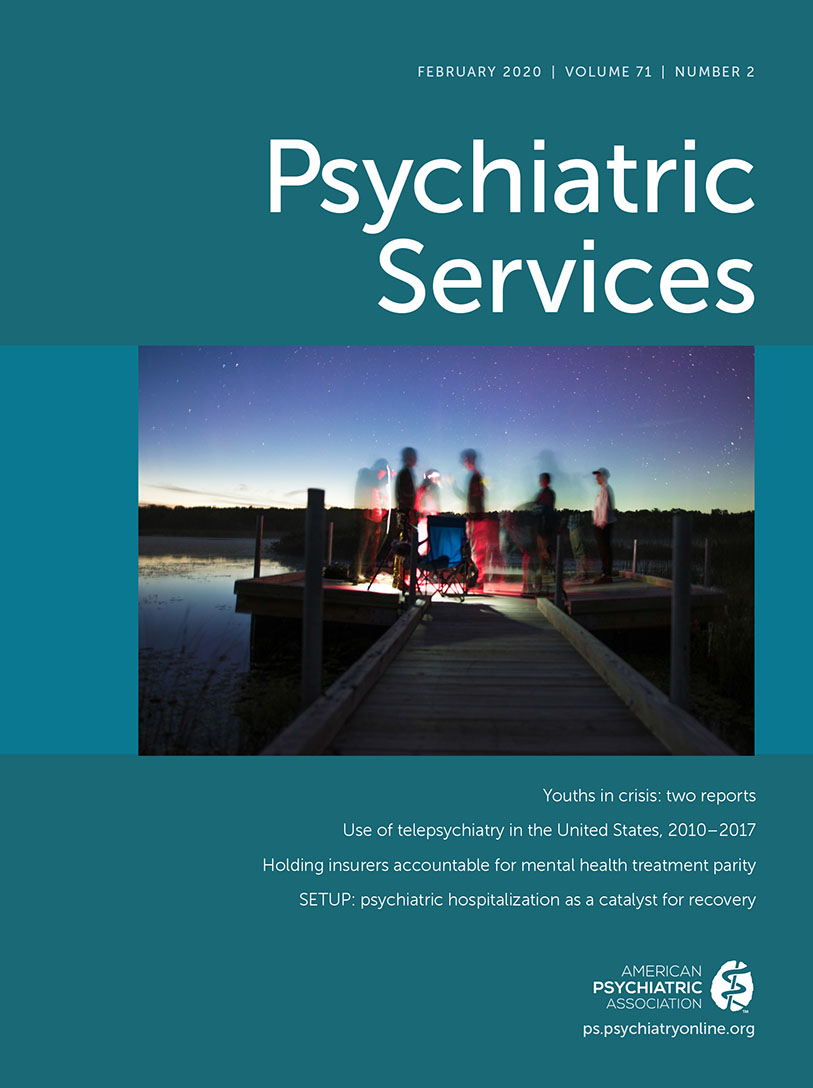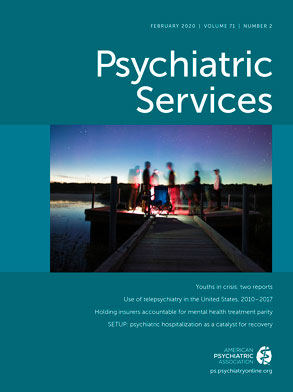Recent articles in this journal have addressed the promise and challenges of Open Dialogue, a community-based, networking approach to dealing with psychiatric crises (
1,
2). Originally developed in Scandinavia as “need-adapted treatment,” an adaptation of family therapy in hospital wards, Open Dialogue’s inclusive, participatory, and nonhierarchical treatment planning was eventually extended to patients’ social networks outside the hospital. The notable prospects of evidence-based approaches to first-episode psychosis notwithstanding (
3), hospitalization can be traumatizing, and treatment is too often punctuated by inpatient stays and haphazard transfers across institutional domains (
4,
5). These realities disrupt continuity of care, compound reentry difficulties, and needlessly increase costs. Correctives like dialogic practice strive to reembed care in everyday community life, minimize hospitalizations, activate lay networks of treatment planning, improve outcomes, and reduce costs.
In 2012, spurred by a federal innovation grant from the Centers for Medicare and Medicaid Services, the New York City Department of Health and Mental Hygiene launched Parachute NYC, a citywide approach to providing a “soft landing” for people experiencing a psychiatric crisis by forgoing hospitalization as the default response to psychiatric crises and maintaining community ties while in treatment. Modeled on Swedish and German prototypes, Parachute was designed to be a preferred alternative that buffered the often alienating effects of conventional treatment through peer support, network engagement, and crisis respite. Distinctively, too, the program trained peers in Intentional Peer Support and fully integrated them into mobile dialogic teams and respite centers. In intent and design, then, Parachute was promoted as “transformational” public mental health practice.
As anthropologists then working at the Nathan Kline Institute for Psychiatric Research, we conducted an implementation analysis of Parachute NYC’s ramp-up and first 3 years (2012–2015). Parachute recruits were offered extensive training in both Intentional Peer Support and dialogic practice, which relied on Intentional Peer Support specialists and Open Dialogue trainers (the latter from Hamburg, Germany, and Stockholm, Sweden). Despite a staggered launch of four teams, start-up was eventful and difficult. In consultation with city officials, our ethnographic team decided to shadow the developing dialogic teams and crisis respites, filing real-time dispatches that detailed obstacles, errors, and misunderstandings as they emerged (
6,
7).
Logistics topped the list of difficulties encountered. Referral of appropriate candidates, rapid deployment of teams, coordinated coverage, staff turnover, and institutional cooperation all presented problems. Success in meeting these challenges was uneven. (A mental health court judge, for example, refused to reinstate a Parachute client, who had had a run-in with police during a paranoid episode, because the judge wanted attendance to be mandatory and monitored; participation in Parachute was apparently insufficiently secure because it was voluntary.) But the actual work of engagement and treatment planning proved most challenging. Unlike their mobile crisis counterparts, these mixed teams of clinicians and peers were expected to cultivate—deliberately and nonhierarchically—working relationships with clients and members of clients’ social network. In effect, the scope and ethics of clinical work had been radically redefined in principle, but still awaited operationalization.
The grounding principles of Open Dialogue and Intentional Peer Support were clear: abiding concern for the dignity of persons in crisis, respect for all relevant voices and perspectives, treatment driven not by diagnosis but by the changing needs of the person and family, availability as needed, continuity of treatment personnel, minimal resort to medication, and flexibly configured home-based meetings. Translating them into viable forms of practice was another matter entirely. The slow pace of engagement, so at odds with customary work in public mental health, was underwritten by a principled “tolerance for uncertainty” and coupled with regular inquiry into participants’ sense of safety. Informing this extended home-based approach was a deep trust in the productive power of dialogism—that lightly guided, arduous, and free-ranging conversation could surface hidden problems bound up in psychiatric crisis and could help improvise means for their resolution.
An Ill-Omened Launch
To the trainers, these challenges—doubtless made more difficult by the novelty of integrating peers and by the inertial drag of prior clinical training—seemed addressable issues related to aptitude and craft, problems to be dealt with in the course of an extensive apprenticeship. This attitude proved overly optimistic. In retrospect, three factors contributed to an especially fraught implementation: inadequate provisions for training and supervision, systemic indifference to the program’s vision, and participants’ insecure livelihoods.
Training.
As Steingard argued (
8), a clinical shift to Open Dialogue often reflects profound dissatisfaction with established practice, even without knowledge of a full-fledged alternative. Open Dialogue’s radical revamping of traditional practice means that novitiates must undergo substantial unlearning and retraining. The approach is hard to learn, is buffeted by contrary institutional interests and efficiency metrics, and often requires solitary work. Furthermore, opting to try a massive course correction without a recognized evidence base (
1) is risky. But, as both Steingard and the Parachute staff discovered, there are benefits: a singular version of collaborative treatment planning, profound clinical humility, disciplined commitment to eliciting and attending to all voices, and—unusual in this line of work—working with people engaged by the treatment enterprise, not alienated from it.
Dialogic practice has stubbornly resisted manualization until recently (
9), and its literature contains few developed case studies. New York recruits were unable to seek guidance from established communities of practice (
6), so dialogic practice had to be learned experientially, through a demanding regimen of staged exercises and role plays. Peer integration further complicated training but was facilitated by a well-developed Intentional Peer Support training regimen and workbook. The upshot was a series of extended makeshift apprenticeships, each staged over 18 months. Uneven attendance (especially after home visits and respite work started) and staff turnover resulted in variable competencies across teams and respite staff. Supervision added its own challenges; neither set of trainers was available for in-person consultation between training sessions, and staff resorted to Skype sessions, often encountering technical challenges.
Uncommitted collaborators.
Their official endorsements notwithstanding, sponsoring agencies and potential mental health allies were unenthusiastic about the novel practice cultures taking shape, greeting them with suspicion and all but ensuring the program’s eventual demise. Agencies had doubtless been caught off guard by the magnitude of changes that democratized treatment planning had introduced into once-familiar routines. Insufficient preparatory work had been done to brief them in advance or to familiarize staff with new approaches, once implemented. Still, our considered opinion was that their skepticism reflected a more general suspicion of long-term treatment commitments in an era of managed care. Despite explicit regulatory provision, the sponsoring agency of the home-visiting Parachute teams failed to convert from grant support to programmatic billing under a “redesigned” Medicaid program, and they reverted to mobile crisis teams. (The respite centers made the switch and are still in operation.)
Precarious livelihoods.
Parachute was an experimental trial, susceptible to the usual hazards of being ignored, resented, actively opposed, covertly sabotaged, and undercut by competing exigencies and broader structural constraints. Dialogic practice, for example, assumes that basic securities are in place to anchor the livelihoods of participants in the social networks engaged by teams. Although these elements may have been present in Sweden, New York personnel regularly scrambled to address unmet material needs (adequate housing, job training, paid time off to participate in network meetings, disability benefits, health insurance coverage)—concerns that are managed by nonclinical agencies in strong welfare states. These social determinants of health can powerfully influence chances of programmatic success. For example, community-level context has been shown to moderate the effectiveness of HIV behavioral interventions (
10).
What Was Learned?
The identification of difficulties in program implementation, determination of their causes when possible, and documentation of the teams’ varied success in surmounting them are valuable takeaways of our full implementation analysis (
https://bit.ly/2Xr0apP). Improvisation proved the watchword of the day, and our own ethnographic research was no exception: schooled in the self-reflective discipline and openness to other voices that are signature features of both dialogic practice and peer support, we wound up sharing provisional impressions, giving feedback and soliciting the same from other parties, and routinely circulating research drafts for comment. And we did so increasingly by drawing upon the discursive tools (phrasing, tone, pacing, polyphony, tension, and trying to accommodate uncertainty) favored by the two schools under study.
The fancy term for what Parachute attempted is “counterhegemonic,” which describes an innovation that not only challenges professional and institutional interests but also seems to diverge from common clinical sense. Tellingly, the one stakeholder group with lasting, if wary, enthusiasm throughout the effort was peers. In retrospect, the program’s disruptiveness could have been foreseen had the interventions been better understood by Parachute’s architects (what it might entail, for example, for agencies to rethink staffing schedules and supervision, opportunities for professional advancement, and routine administrative decision making). Better preparation among potentially collaborative bureaucracies (clinics, hospitals, courts, and welfare administration) surely would have helped. And imagining how to counter an increasingly cost-conscious mental health system is difficult, even given favorable preliminary estimates of Parachute’s comparative costs made by an outside examiner.
Even under these less-than-hospitable conditions, the mixed teams made major strides toward a hybridized form of practice and an inclusionary stance toward family and friends. Peers, risking exploitation of their emotional labor, were ready to persist in this kind of caregiving (
11). If the end product was well short of what a serious reconfiguring of crisis response in public mental health would look like, the effort serves as a useful index of what it would take.
Transitioning counterhegemonic innovation from a curiosity to a contender requires political organization. The exemplary value of evidence-based outcomes—something Parachute was poorly positioned to attempt and too short-lived and underdeveloped to provide—may not suffice when radical change is afoot. In Europe, the sustainability of Open Dialogue has suffered from want of social movements in its support, and the program’s champions have grudgingly gone from proselytizing for full system change to calling for partial adoption of dialogic practices where feasible (
12).
Is this simply to say that in nixing further support for Open Dialogue trials, Mueser (
2) was right about the risks, but for the wrong reasons? Might the better takeaway be to recognize that the social reorganization implicit in the dialogic embrace of ordinary people and peer labor as active treatment agents will necessitate a better prepared community laboratory than that traditionally accorded demonstration programs? On a small, well-coordinated scale, where the necessary groundwork has been laid, that may yet be possible. In the meantime, to settle for partial and fragmentary adaptations may be to so rig the chances of success as to all but ensure further evidence of its elusiveness.
Acknowledgments
The authors thank the New York State Office of Mental Health and Research Foundation for Mental Health for salary support during the research.

